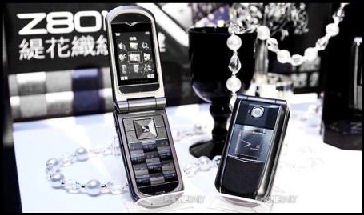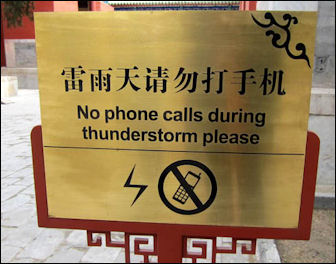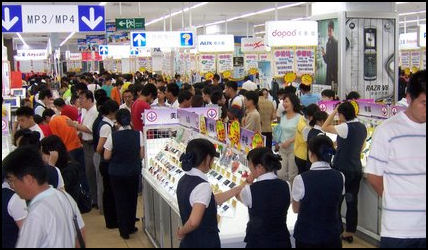CELL PHONES IN CHINA
 China is the world’s largest mobile phone market. Nearly everyone in China has a mobile phone. In 2015, China recorded 1.3 billion mobile subscribers in its domestic market, just shy of its population. Cell Phones: (mobile cellular and smart phones): total subscriptions: 1,696,356,000 (2020); subscriptions per 100 inhabitants: 117.9 (2020 est.). No. 1 in the world.[Source: CIA World Factbook, 2022]
China is the world’s largest mobile phone market. Nearly everyone in China has a mobile phone. In 2015, China recorded 1.3 billion mobile subscribers in its domestic market, just shy of its population. Cell Phones: (mobile cellular and smart phones): total subscriptions: 1,696,356,000 (2020); subscriptions per 100 inhabitants: 117.9 (2020 est.). No. 1 in the world.[Source: CIA World Factbook, 2022]
China kind of skipped over the computer revolution — even the mass retailing revolution — and went straight to the mobile phone revolution. Jiayang Fan wrote in The New Yorker: “In China, what is sometimes called “the shift to mobile” never happened — hasn’t needed to happen — because the country’s wealth is too recent for people to have been swept up in the PC revolution, the way Americans were. Instead, they went straight to phones, an example of a phenomenon known as leapfrogging, in which non-participation in an older technology spurs early adoption of whatever innovation comes next. Jack Ma, of Alibaba, has argued that the entire e-commerce sector in China exemplifies this pattern: people happily shop online because there haven’t been Walmarts everywhere. In the U.S., “e-commerce is a dessert, ” he said. “In China, it’s become the main course.” [Source: Jiayang Fan, The New Yorker, July 23, 2018]
Until 2008, China's mobile phone service was provided by the three companies: 1) GSM service from China Mobile; 2) GSM and CDMA service (begun in 2002) from China Unicom; and 3) PHS service from the two fixed phone companies: China Netcom and China Telecom. In 2008, a year before the 3G service was granted, the Chinese telecommunications industry was reorganized. As of the late 2010s, nearly 29.6 percent of mobile consumers or 386 million users were on the LTE 4G network.
The domestic sales of mobile phone reached 100 million in China in 2006 and 190 million in 2007. Demand was fed by the rapid growth of new mobile phone users and old customers' upgrading to new devices. Of 190 million mobile phones sold in 2007, 140 million were made through formal channels, while the rest were made through informal channels such as smuggling, counterfeiting and renovating. In 2021, China produced about 370 million phones.
Revenue for the Mobile Telecommunications industry in China is was around $142.7 billion in 2021 According to Ibisworld: Revenue declined by 7.9 percent in 2019, due to the decrease in mobile voice call duration and slight growth in mobile data traffic. However, starting in 2020, the use of 5G technology has promoted the development of this industry. The industry was expected to account for about 61 percent of China's total telecommunication services sector by revenue in 2021. Growth in the number of mobile phone users and value-added services have supported industry revenue growth over the past five years. [Source: “Mobile Telecommunications Industry in China - Market Research Report. Ibisworld, December 6, 2021]
See Separate Article APPLE IN CHINA: factsanddetails.com
RECOMMENDED BOOKS: “Little Rice: Smartphones, Xiaomi, and the Chinese Dream” by Clay Shirky, George Backman, et al. (2015) Amazon.com; “The Xiaomi Way: Customer Engagement Strategies That Built One of the Largest Smartphone Companies in the World” by Li Wanqiang Amazon.com; “Communication in China: Political Economy, Power, and Conflict” by Yuezhi Zhao (2008) Amazon.com; “The Transformation of Political Communication in China: From Propaganda to Hegemony” by Xiaoling Zhang Amazon.com; “Tech Titans of China: How China's Tech Sector Is Challenging the World by Innovating Faster, Working Harder, and Going Global” by Rebecca A. Fannin, Janet Metzger, et al. Amazon.com; “Trafficking Data: How China Is Winning the Battle for Digital Sovereignty” by Aynne Kokas, Hannah Choi, et al. Amazon.com; “Networking China: The Digital Transformation of the Chinese Economy” by Yu Hong (2017) Amazon.com; “China's Leap into the Information Age: Innovation and Organization in the Computer Industry” by Qiwen Lu (2000) Amazon.com;
History of Cell Phones in China
In 1987, wireless telephone communication in the modern sense was started by the Ministry of Posts and Telecommunications of China, using TACS technology. A nationwide network was completed in the following year. In 1994, the fixed telephone company (China Telecom) and two mobile phone telephone companies (China Mobile and China Unicom) were spun off from the Ministry of Posts and Telecommunications. In 2000, China Telecom was forced to spin off its mobile service (now China Mobile) and satellite services (now ChinaSat). [Source: Wikipedia]
China became the world’s largest mobile phone market very quick. The number of cell phones rose from near zero in 1990 to around 3.7 million in 1995 to 17 million in 1998 to 100 million in 2001 to 200 million in 2003 to 383 million in December 2005 to 409.7 million in March 2006 and 592 million in July 2008 and 650 million users in 2009. At that time new subscribers were being added at a rate of around 7 million a month.
During the 1990s, China poured more than $10 billion into erecting a national mobile phone network. Much of the work was done by foreign companies like Cisco Systems, Ericsson, Motorola and Nokia. At this time in some rural areas the cell phone reception was only good if you climbed a hill. In the 2000s, the Chinese developed homegrown 3G technology to run its mobile telephone network and beam high-speed Internet connections to phones and handheld computers. Chinese companies such as Datang Telecom, Huawei technologies and ZTE Corp. worked on developing homegrown standards that not only saved them from paying royalties to foreign companies but also earned them billions in revenues when their systems went abroad.
In some parts of China you can find homes without toilets, without even out houses, but the residents have cell phones or smart phones. A communications analyst told the Los Angeles Times, “The mobile phone has been the young person's biggest, most expensive possession. The mobile phone is what people carry with them. This is the badge that [says], “I’m moving up.” Many people have multiple cell phone account for business and personal use. One of he most popular films in 2004 was “Cell Phone”, a dark comedy about a despicable TV talk show host who used his cell phone and text messages to hide his relations with his mistress and his lover from his wife.
China began issuing third-generation phone licenses in January 2009. Third generation phones were much faster and better able to handle the Internet and videos. The move made telecom operators more interested in content. By this time the cell phone penetration in some urban area was near 100 percent. There were more than 900 different handset models available, compared to only 80 or so in the United States. Companies like Samsung came out with new handsets models every week, often with the latest with fast Internet access. On average at this time Chinese changed their cell phones every three or six months. It was not unusual for young people to change cell phones four times a year, sometimes spending a month’s salary to obtain the latest styles and touch screen models that allowed users to use Chinese characters to communicate.
Mobile Phone Service Providers in China

Karaoke cell phone In May 2008, it was announced that China’s phone companies would merge into three large groups, bringing together cell phone and fixed line operators. The plan was hatched to create competition for China Mobile.
After the 2008 reorganization of China's telecommunication industry, there are now three mobile phone service providers. 1) China Mobile continues the old China Mobile's service, absorbed China Railway Communications, and began 3G service using TD-SCDMA, China's disputed own technology. 2) China Unicom continues the old China Unicom's GSM service, absorbed the old China Netcom's network of fixed telephones in the north of the Yangtze River in China, and started 3G service using W-CDMA technology. 3) China Telecom continues PHS service of the old China Netcom and China Telecom, continues the old China Telecom's network of fixed telephones in the south of the Yangtze River, and began 3G service using CDMA2000 technology.
China Mobile and China Unicom are both are based in Beijing. They expanded aggressively in the 2000s by scrapping charges for incoming calls and moving into towns and villages. China Mobile, China Unicom and China Telecom all have fixed line and mobile telephone services and offer broadband internet, digital television and Internet television. It
China United Network Communications Group (China Unicom) is the third-largest wireless carrier in China, with 310.45 million subscribers as of June 2021. Owned by the Chinese government, it earned US$29.4 billion in revenues and $135 billion in assets in 2016. In the 2000s, China Unicom was China’s No. 2 cellular phone company and China’s 3rd largest telecom company. Formed in in 1994, it had 148 million accounts in October 2009, down from 160 million in 2007, and 90,000 employees and $4.5 billion in revenues in 2001. NBA basketball star Yao Ming was it primary pitchman. It has struggled to attract new users.
China Telecom is the second-largest wireless carrier in China, with 362.49 million subscribers as of June 2021. Owned by the Chinese government, it earned US$52 .6 billion in revenues and $97.4 billion in assets and over 286,000 employees in 2016.
Competition has been very fierce between these companies and some smaller, upstart companies anxious to grab a share of this lucrative business. In some extreme cases executives of one company have ordered thugs to cut the lines or rough up employees of rival companies. Consumers have benefited by the competition and enjoy low phone and Internet rates.
Foreign telecommunication companies were expected to be big winners when China was admitted to the WTO and foreign companies were allowed to invest in Chinese telecommunications firms and restrictions on cell phone use within China were dropped. But that didn’t happen. Foreigners are barred from owning majority control of long distance, cellular, Internet and other service ventures. Motorola was one of the top companies in China in the early 2000s. As of 2002, Motorola was the biggest cell phone maker in China. Their pagers and cell phones were everywhere. Now the company is virtually non-existent in China
China Mobile
China Mobile is China’s No 1 telecom company, the world’s largest telecom company and the world’s largest cell phone operator in terms of network capacity and number of customers. China Mobile dominates the Chinese market. It had 945.5 million subscribers as of June 2021 and 456,239 of employees in 2019.
China Mobile had revenues of US$108 billion and assets US$243 billion in 2019. It is 72.72 percent owned by the China government. The company made about $15 billion in profit in 2008 and had 554 million subscribers as of June 2010. In 2001 it had 114,000 employees and $16.2 billion in revenues. It had a deal with Vodaphone.
In 2006, China Mobile was named as the fourth most valuable brand in the world. At that time some thought its stock was highly inflated. It was worth 41 percent more than AT&T but only brings in two thirds of its revenue. The company had a profit of $15 billion in 2010. At that time growth was slowing as a result market saturation but things picked up as China embraced smart phones..
Mobile Phone Industry in China
Wireless communication is regulated by the Ministry of Industry and Information Technology. The mobile phone industry in China is huge and included research of new technology, manufacturing of mobile phones and building of communications networks and providing parts for such networks. Important Chinese companies include Huawei Technologies and ZTE. Huawei surpassed Nokia-Siemens Networks and Alcatel-Lucent to become the second largest manufacturer of telecommunications equipment, after Ericsson, in 2009. [Source: Wikipedia]
Major mobile phone manufacturers in mainland China are Haier, Hisense, Huawei, LeEco (former Letv), Lenovo (Vibe lineup), Meizu, Oppo, OnePlus, Realme, TCL (including Palm), Vivo, Xiaomi, ZTE, Infinix. International companies such as Apple, Samsung, LG, HTC and Google rely on Chinese parts and labor, much of which is provided by Foxconn
In 2007, 600 million mobile phones were made in China which accounted for over 25 percent of the global production. In the 2000s, there are 30 domestic cell phone makers. At that time TCL Mobile Communications did very well in the cell phone market, in part by making products geared for the Chinese market, even producing diamond-studded models for the Beijing elite. Today arond 400 million phones are made in China each year.
China's mobile phone market is dominated by products with price under US$300 dollars. Products at this price have accounted for 60 percent of the whole mobile phone market, Since 2011 smartphones, especially one running on the open source Android operating system, have become increasingly popular in China. By 2016 smart-phones outsold other kinds of mobile phones in the Chinese market. Android allowed factories to produce smartphones with increasing ease, which in turn has allowed prices to decrease to below US$150. These cheap smartphones have made it even the poorest and remotest parts of China and have been to every corner of the world
Mobile Phone Use in China

Most mobile phone services are prepaid. Pre-payment can be made by buying a card (50 or 100 yuan) and calling the mobile phone provider, or through commercial banks. You can top-up the account using WeChat top-up vouchers, Alipay and credit cards online.
In China there is a clear distinction between mobile phone and mobile phone service unlike some countries such as Japan where the mobile phone is sold by and locked to the mobile phone service companies. This custom was broken in 2009 when Apple introduced iPhones to China. Stealing of mobile phones is quite common. When a mobile phone is stolen, the owner must visit the mobile phone service provider to cancel the previous SIM card, in order to retain the previous phone number and pre-payment.
A short message (SMS) or duanxin, usually 0.10 yuan per message (up to 160 alphabetic or 70 Chinese characters), can be sent to any other cell phones across different cell phone service companies, GSM, CDMA or PHS. Multimedia Messaging Service (MMS) or caixin is also available, usually 0.3 yuan per message (up to 50 kilobytes).
See Smart Phones in Rural Chinese Under RURAL DEVELOPMENT AND MODERNIZATION IN CHINA factsanddetails.com
Top Smartphone Brands in China
The top-selling smartphone brands in Chinese market in 2022 were: 1) Vivo (22 percent); 2) Oppo (including OnePlus, 21 percent); 3) Apple (16 percent); 4) Xiaomi, 5) Honor and Huawei (tied) and 7) Realme. according to market research company Counterpoint Research. Realme saw the largest a year-on-year growth — 379 percent — to take 3 percent of market share. All the other brands accounted for 4 percent of the market share in 2021, during which full-year smartphone sales declined 2 percent year-on-year for the fourth consecutive year. Lengthening upgrade cycles have presented an ongoing dilemma for Chinese smartphone brands looking to maintain growth at home, as consumers delay purchasing new devices. [Source:s Reuters, January 27, 2022, chinadaily.com.cn, February 8, 2022]
Vivo and Oppo are two Android handset brands under the privately-owned BBK Electronics. Oppo is owned by billionaire Duan Yong Ping, who made his name selling cheaper phones in rural China (where Oppo has 200,000 retail locations) and Southeast Asia. Its R9S looks like an exact copy of an iPhone 7 — a winning formula in China, according to Fortune . Vivo is Oppo’s sister brand. Also owned by Duan, it focuses on its smartphones’ camera, a major selling point in selfie-crazed China. Celebrity endorsements and its sponsorship of the NBA have helped the brand grab a large market share. Huawei is China’s network-equipment giant. It sold an estimated $26.5 billion worth of phones, or 140 million handsets, in 2016. It’s the only Chinese phonemaker whose devices are generally seen as being on par with Samsung’s in quality — which helps explain they company has done well in Europe. [Source: Scott Cendrowski, Fortune, January 25, 2017]
Scott Cendrowski wrote in Fortune in 2017: “Worldwide, Apple and Samsung dominate pricey smartphone sales, accounting for about a third of the market. But the next several names on the global bestseller list include four lower-cost Chinese competitors that collectively sell almost as many handsets as the big two. In China's smartphone market" Oppo, Vivo, Huawei and Xiaomi 'have been closely matched competitors over the last few years, taking turns at the number-one spot. Being No. 1 in China isn't necessarily very profitable, however, as there are always new competitors willing to lose piles of money to build market share. [Source: Scott Cendrowski, Fortune, January 25, 2017]
See Separate Article APPLE IN CHINA: SUCCESS, CRITICISM AND COMPETITION factsanddetails.com
Meteoric Rise and Fall of Xiaomi — the “Apple of the East”
Xiaomi’s phones were all the rage in the mid 2010s, but they quickly fell out of favor due to mediocre reviews and a lack of retail distribution. Within 18 months in 2014-2016 the company went from being the world's most-valuable startup worth $40 billion to have a valuation of less than $4 billion. The company regrouped somewhat. In 2022 it was the fourth best-selling smart phone brand in China. In the late 2010s, the formerly online-sales-only company was making a big push to open retail stores.
Xiaomi was founded in 2010 founded by Lei Jun its CEO. By 2012 it was worth more than Blackberry maker Research in Motion, according to private market valuations. At that time their smartphones were so popular they sell out in minutes after going on sale online. The companymade close to $1 billion in the first half of 2012, when it sold more than 3 million phones. Lei Jun drew Steven-Job-like crowds to Xiaomi’s launch events. [Source: Melanie Lee, Reuters, August 16, 2012]
Among those who invested heavily in Xiaomi was Yuri Milner, a legendary investor who invested early in Facebooks and Alibaba and made huge profits on those investments. He predicted Xiaomi's valuation could more than double to $100 billion. "In every conceivable benchmark, it's almost unprecedented in terms of its speed of growth," Milner told Bloomberg. In December 2014 one of the reasons David Gilbert wrote in the International Business Times: “ Milner was so confident about Xiaomi's potential to double in value was the fact that it only sold smartphones in a handful of Asian countries. The calculation was that once Xiaomi launched its smartphones in western Europe and the United States, it would become a global player. “However, the problem is that Xiaomi simply does not have the patent portfolio to enter these markets. Long accused of copying hardware and features of established players like Apple and Samsung, Xiaomi is completely unprepared to enter a more mature market, where it would immediately face a volley of patent lawsuits, stymieing any chance it has of establishing itself as a major player. [Source: David Gilbert, International Business Times, August 18, 2016]
“As well as the huge potential for growth, investors cited the company's fanatical customer base in China as a major advantage, with Xiaomi consistently hailing the fact that its users were among the most deeply engaged and — according to the company — willing to buy into an ecosystem of Xiaomi products, which had the company's smartphones at its heart.The problem with this analysis however is that customers — particularly Chinese customers — are very savvy and have little or no brand loyalty. According to a 2014 study by research firm Bain & Company, brands in China are constantly having to win new customers due to this lack of loyalty, and while Xiaomi might have once been able to convince these new customers with their offerings, that is clearly no longer the case.
“According to figures released by research firm IDC, Xiaomi saw sales of its smartphones drop by almost 40 percent in China during the second quarter of 2016 when compared to the same period in 2015. The overall Chinese market grew during the same period by 4.6 percent and while Apple suffered a similarly large drop in sales, Xiaomi's real competitors in the mid-to-low end of the market — Huawei, Oppo and Vivo — all saw significant growth. In the 12 months following its record-breaking valuation, Xiaomi missed smartphone sales targets — twice — as well as revenue targets.
“Xiaomi's meteoric rise was based on one simple fact: It was able to produce smartphones with premium hardware and features which cost a fraction of those on sale from Apple or Samsung. However that advantage rapidly vanished when multiple manufacturers followed suit and produced their own smartphones which offered premium specs at low prices. However, unlike Xiaomi, its competitors were able to offer something new and something innovative. Vivo offered curved screens; Oppo and OnePlus dangled rapid charging; LeEco offered exclusive content; and Huawei threw in dual lens cameras and fingerprint sensors. "I think Xiaomi's current performance and growth in the smartphone space has stalled, as competitors with better R&D, vertical manufacturing expertise, and a wider distribution and geographic footprint has surpassed the brand," Neil Shah, analyst with CounterPoint Research told IBTimes UK. "Xiaomi's inability to innovate independently is one of the key reasons." Another issue for Xiaomi is its continued focus on the ultra-budget end of the market with products like its RedMi series, despite clear evidence that Chinese customers were willing to pay more for their smartphones.
Most Popular Apps in China

Wechat and QQ are the two most widely used mobile phone applications (apps) in China. As of the late 2010s young people tended to use QQ more, while Wechat was the choice among older adults. Many people spend a good portion of their daily lives on social media in China, particularly on WeChat. Twitter-like Sino Weibo is another popular app. Other apps like Alipay are often serve primarily as utilities, allowing people do things like pay for something. [Source: Derek Feng, Quora.com, 2016]
1) WeChat — owned by Tencent — Social media and networking — is the most popular app in China with over 1 billion active users each month, It offers services and features that would require dozens of apps to achieve otherwise. Because of this, it has long been the dominant force in the Chinese app market and is known as a ‘super app’ . WeChat is known as Weixin in in China, It has been described as the most “social” social media in the world. Over 90 percent of its users access it daily. [Source: Henrik Saetre, AdChina, Trustdata, top apps in the Chinese mobile app store were: October 2019]
2) QQ — owned by Tencent — Social media and networking — 709 million monthly active users. QQ is an instant messaging service and web portal. It offers a range of services including online social games, music, shopping, microblogging, movies, plus group and voice chat software.
3) AliPay — owned by Alibaba Group — online payment — 697 million monthly active users. AliPay is a third-party mobile and online payment platform, founded in 2004. It the world’s No. 1 mobile payment service, and the world’s second largest payment service.
4) TaoBao — owned by Alibaba Group — online shopping — 690 million monthly active users. TaoBao is an online shopping run by Alibaba. It is the world’s biggest e-commerce website and the eighth most visited website in the world according to Alexa data,.
5) Tik Tok (DouYin) — owned by ByteDance — video sharing — 376 million monthly active users. Tik Tok is a video-sharing social networking service. Users create and share short lip-sync, comedy, and talent videos. DouYin and TikTok are run on separate servers to ensure DouYin complies with Chinese censorship restrictions.
6) Baidu — owned by Baidu — Utility — 299 million monthly active users. Baidu’s search engine is the fourth largest website in the world according to Alexa ranking.
7) Pinduoduo — owned by Colin Huang — online shopping — 266 million monthly active users. Pinduoduo is an e-commerce platform allowing users to participate in group buying deals. Among its products are home appliances, groceries and a wide range of other stuff. Many goods are purchased as a group to get significant discounts.
8) iQiyi — owned by Baidu — video streaming — 253 million monthly active users. iQiyi is one of the largest online video platforms in the world. As of 2019, users spent around 6 billion hours watching video content on iQiyi each month.
9) Weibo — owned by Sina Corp — micrblogs — 253 million monthly active users. Weibo, means ‘microblog’ in Chinese. Sort of like a hybrid of Facebook and Twitter, it is is an open and public platform, and is used by Chinese for communication, exposure, outreach, trend-spotting, and entertainment.
10) WiFi Master Key — owned by LinkSure Network — Internet use tools — 228 million monthly active users. WiFi Master Key is the world’s first and largest peer-to-peer Wi-Fi sharing platform for free WiFi access. The app leverages the sharing economy, cloud computing, and big data to provide users with a safe and free connection shared by Wi-Fi hosts around the world.
11) Toutiao — owned by ByteDance — news and content provider — 225 million monthly active users.Toutiao is a news and information content platform that uses an algorithm to analyse aspects of users and content to best match the two and provide news and content tailored for each individual user.
12) QQ Browser — Tencent — Internet use tools — 218 million monthly active users. One of the most popular browsers in China, QQ Browser is based on the chromium web browser and offers features such as tabbed windows and integration with other chat platforms.
13) Kwai (Kuaishou) — Tencent — video sharing — 212 million monthly active users. Kwai is a video sharing app that is popular in China and outside it, topping Google Play’s and Apple App Store’s “most downloaded” lists in eight other countries. 14) Tencent Video — owned by Tencent — video streaming — 207 million monthly active users. Tencent is a video streaming website with around 100 million subscribers in 2019. It supports online VOD and TV broadcasts.
15) KuGou — owned by Tencent — music streaming — 183 million monthly active users KuGou is a music streaming and download platform created in 2004. As of 2019, it was the largest music streaming service in the world and has the greatest marketshare for online music in China, at 28 percent.
16) UC Browswer — owned by Alibaba Group — Internet use tools — 151 million monthly active users. UC Browser was developed by the Singapore-China-based mobile Internet company UCWeb. It is bigger than Google Chrome in India and Indonesia.
17) Tencent News — owned by Tencent — news and content provider — 141 million monthly active users. Tencent News is one of the leading news-apps of China. Its content is released via QQ, where it joins other services.
18) YouKu — owned by Alibaba Group — video streaming — 132 million monthly active users. YouKu is a video hosting service. It operates as a subsidiary of Alibaba Group and has been described as hybrid of YouTube and Netflix.
19) YingYongBao — owned by Tencent — App Management — 122 million monthly active users.YingYongBao is a major Android app store and app management tool. It has had on impact on shaping China’s economic and social life in that it facilitates distribution and sale of other apps.
 20) Meituan — owned by Meituan Dianping — lifestyle and service tool — 120 million monthly active users. Meituan is a group-buying website for local food delivery services, consumer products, and retail services. Founded in 2010, the site offers daily deals by selling vouchers on local services and entertainment.
20) Meituan — owned by Meituan Dianping — lifestyle and service tool — 120 million monthly active users. Meituan is a group-buying website for local food delivery services, consumer products, and retail services. Founded in 2010, the site offers daily deals by selling vouchers on local services and entertainment.
21) Amap — Alibaba Group — map service — 115 million monthly active users. Amap belongs to AutoNavi Software Co, a web mapping, navigation and location-based services provider, founded in 2001. It was acquired by Alibaba Group in 2014.
22) JD — owned by Pentland Group — online shopping — 115 million monthly active users. Also known as Jingdong (formerly 360buy), JD is a Fortune 500 e-commerce company. It is one of the two largest business to customer online retailers in China based on revenue and transaction volume.
23) iXiGua — owned by ByteDance — video streaming — 105 million monthly active users. iXiGua offers personal recommendations for video content to its 300+ million users. It had over 4 billion average daily video views and over 70 minutes of daily per capita use per month in 2019.
24) Tencent Mobile Manager — owned by Tencent — Internet use tools — 102 million monthly active users. Tencent Mobile Manager offers various security options for apps based on Tencent’s technical experience with over 1.2 billion mobile devices. Among the service it offers are security assessment, app reinforcement and compatibility testing for a range of industries.
25) 360 Security — owned by Qihoo 360 — Internet use tools — 101 million monthly active users. 360 Security was developed by internet security company Qihoo 360, which has has more than 700 million users for its Mobile Antivirus products.
See Separate Articles: POPULAR WEBSITES AND INTERNET COMPANIES IN CHINA factsanddetails.com ; SOCIAL MEDIA IN CHINA factsanddetails.com ; E-COMMERCE IN CHINA AND ONLINE SHOPPING IN CHINA factsanddetails.com
Exploding Mobile Phone Kills Man in China
In February 2009, man died after his mobile phone exploded, bursting an artery in his neck, The Telegraph reported. The shop worker from Guangzhou, China, died moments after he put a new battery in his phone. It was believed that he may have just finished charging the battery and had put the phone in his breast pocket when it exploded. [Source: The Telegraph, February 3, 2009]
The Shin Min Daily News said a n employee at the shop told local media that she heard a loud bang and saw her colleague lying on the floor of the shop in a pool of blood. The employee said the victim had recently changed the battery in his mobile phone. Police investigated what caused the explosion and whether the phone was counterfeit. The maker and model of the phone were not revealed.
Local reports said that this was the ninth recorded cellphone explosion in China since 2002.The Shin Min Daily News published advice for consumers on how to avoid being hurt by exploding mobile phones: 1) Always use original batteries; 2) Do not expose your mobile phone to high temperatures, and avoid exposing it to direct sunlight; 3) Avoid long phone conversations.
'Big Brother Cell Phone Surveillance in China?
Leo Lewis wrote in The Times in 2011, “Beijing is considering plans to launch a mobile phone tracking system that will put the day-to-day movements of 17 million residents of the Chinese capital under 24-hour, 'Big Brother' surveillance. The "travelling efficiency" program has officially been set up to smooth road and pedestrian traffic but the operation will also allow the Beijing authorities to monitor the precise movements of the capital's mobile phone users. [Source: Leo Lewis, The Times, March 4, 2011]
If it is approved, the project, known as the "Information Platform of Realtime Citizen Movement", will draw on information extracted from people's mobile phones, local cell stations and satellite-tracking technology. By processing the data with powerful computers, the authorities could be supplied with unprecedented levels of live information on the location and trajectory of all mobile users in the capital. Communications specialists have decried the plans as a poorly disguised attempt at privacy invasion.
The information extracted from large numbers of mobile phones could give the authorities a constantly churning map of where ordinary Chinese are gathering - allowing them to judge at what point a street full of shoppers becomes a potentially subversive mob in need of an immediate crackdown. Chen Derong, Professor of Wireless Communications at Beijing University of Posts and Telecommunications, said the proposed system had nothing to do with monitoring traffic.

Protests in Xiamen
Text Messages in China
The Chinese do more text messaging than anyone else. This is thought to be partly because it is such a cheap way to communicate and because a lot of information can be packed into a few characters. A total of 429 billion text messages were sent by cell phones used in 2006, an equivalent of 927 per user, or 33 billion a month, more than any other country. A total of 217.8 billion text messages were sent used in 2004, a 58.8 percent increase from 2003 and as many as the rest of the world combined. Text messaging is popular because it is cheap and most Chinese don’t have the money to make calls.
Chinese vastly prefer text messaging to e-mail. They prefer the immediacy and convenience of text messaging. Plus almost everybody has a cell phone while a computer is still out of reach for many people. Chinese chat, exchange greetings, pass on jokes and flirt with text messages. During the mid-autumn festival in 2007, 2 billion messages were sent in a single day, most greetings and well wishes. At that time nine out of ten cell phone users in China sent text messages, compared to only 49 percent of cell phone users in the United States.
Advanced cell phones with a stylus allow users to draw the characters they want on the screen. Many older people prefer this method. Younger people prefer using the Romanized sound system with a lot of abbreviations . There are text message services that provide weather reports, novels, advice for the heartbroken, digital “pets,” music and pornography. People can vote for their favorite idol on television games shows with messages. Mobile gaming is big and lucrative. Among the games that have done well are trivia quizzes, adventure games and adaptions of rock, scissors, paper. There are also a number of schemes that offer fake cash prizes and illegal services such as gambling and prostitution.
Text Messages and the Government in China
The government has clamped down on text messaging service that offer pornography and some forms of entertainment and installed technology that allows them to snoop on users. The effort was ostensibly set up to cut down on text pornography but can also be used for surveillance of any user. The technology is similar to what is used to monitor the Internet and block websites and find key words.
The government routinely monitors private e-mail, telephone calls text messages and electronic communications with 2,800 surveillance centers..A campaign in 2005, found 107,000 illegal short messages and shut down 9,700 cell phone accounts. Banking scams, illegal lotteries, prostitution and pornography services made up the majority of the shut down sites, The Venus Inor Tech surveillance system filters messages deemed to be “false political rumors.”
The construction of a $1.4 billion chemical factory in Xiamen was halted after citizens there launched a successful text messaging campaign. Widely-distributed messages used inflammatory language comparing the chemicals produced at the plant to nuclear bomb material and warned of leukemia and birth defects. The messages reached more than 1 million cell phones and reached nearly all of Xiamen’s 1.5 million residents through cell phone, word of mouth or messages painted on building walls. Angry messages about the chemical factory were removed from the Internet but the text messages were so widely disseminated using the short message system (SMS) from so many sources at so many different times the government was helpless to do anything about it. One blogger wrote “SMS is a widely used communications method, more than the Internet. Only a certain amount of people use the Internet, but almost everyone has a cell phone.”
Chinese authorities have technology to monitor cell phone messages and track their sources. They they tried to block message in Xiamen but when people send out messages to their friends and family members and they in turn send messages to more people information spreads in exponential fashion and is difficult to stop. Once the text message campaign gained momentum it took on a life of its own. In early June 2007, demonstrations with 10,000 participants were held and Xiamen began getting nationwide coverage

Cell phones sales
China Mobile Official Sentenced to Death
A former executive at China Mobile, one of this country’s biggest state-owned telecommunications companies, was sentenced to death with a two-year reprieve for accepting bribes, according to Xinhua, the state-run news agency. David Barboza wrote in the New York Times Zhang Chunjiang, the former vice chairman of China Mobile was charged with accepting more than $1.15 million in bribes while working at a series of state-run telecom companies between 1994 and 2009, when he was removed from his post. The two-year reprieve means that with good behavior his sentence could be commuted to life in prison. The sentence, which was handed down by a court in north China’s Hebei province, is the latest development in an unfolding corruption investigation into this country’s powerful telecom oligopoly. [Source: David Barboza , New York Times July 22, 2011]
While state executives and government officials are regularly arrested on corruption charges, only a handful have received the death penalty in recent years. Recently, prosecutors have focused their attention on the telecom industry. At least seven other executives from China Mobile are under investigation in corruption cases, according to the nation’s state-run news media. And investigators are also looking into the role of several prominent Chinese businessmen, including Zeng Liqing, one of the founders of Tencent, a top Chinese Internet company, according to Caixin magazine, one of the nation’s most respected publications.
State-run news media said that Mr. Zhang, the 53-year-old former China Mobile executive, confessed to his crimes and therefore was given a penalty mitigated by the two-year reprieve. Xinhua said Mr. Zhang took the bribes while working as deputy director of the Liaoning Provincial Postal Administration, and also while working as general manager of the China Netcom Group and party chief and deputy general manager of China Mobile.
Image Sources: Textually speaking blog; Cgstock http://www.cgstock.com/china ; Picasaweb Jeff; China Digital Times, blogger Jessica ; Wiki Commons ; Asia Obscura
Text Sources: New York Times, Washington Post, Los Angeles Times, Times of London, National Geographic, The New Yorker, Time, Newsweek, Reuters, AP, Lonely Planet Guides, Compton’s Encyclopedia and various books and other publications.
Last updated May 2022
